Curriculum Proposal Project: Early Years Learning Framework EYLF
VerifiedAdded on 2023/05/30
|10
|2367
|393
Project
AI Summary
This curriculum proposal outlines an approach to early childhood education using the Early Years Learning Framework (EYLF). It emphasizes the importance of the environment, individual children's strengths and interests, and the roles of educators, families, and the community. The proposal details intentional teaching strategies, incorporating various curriculum areas like mathematics, literacy, and sustainability. It justifies the proposal as an example of best practice, influenced by research, theory, and beliefs about child development, and highlights the representation of curriculum frameworks in supporting children's learning and well-being. The document underscores the significance of creating a nurturing emotional and physical environment to foster enthusiastic participation in the learning process.
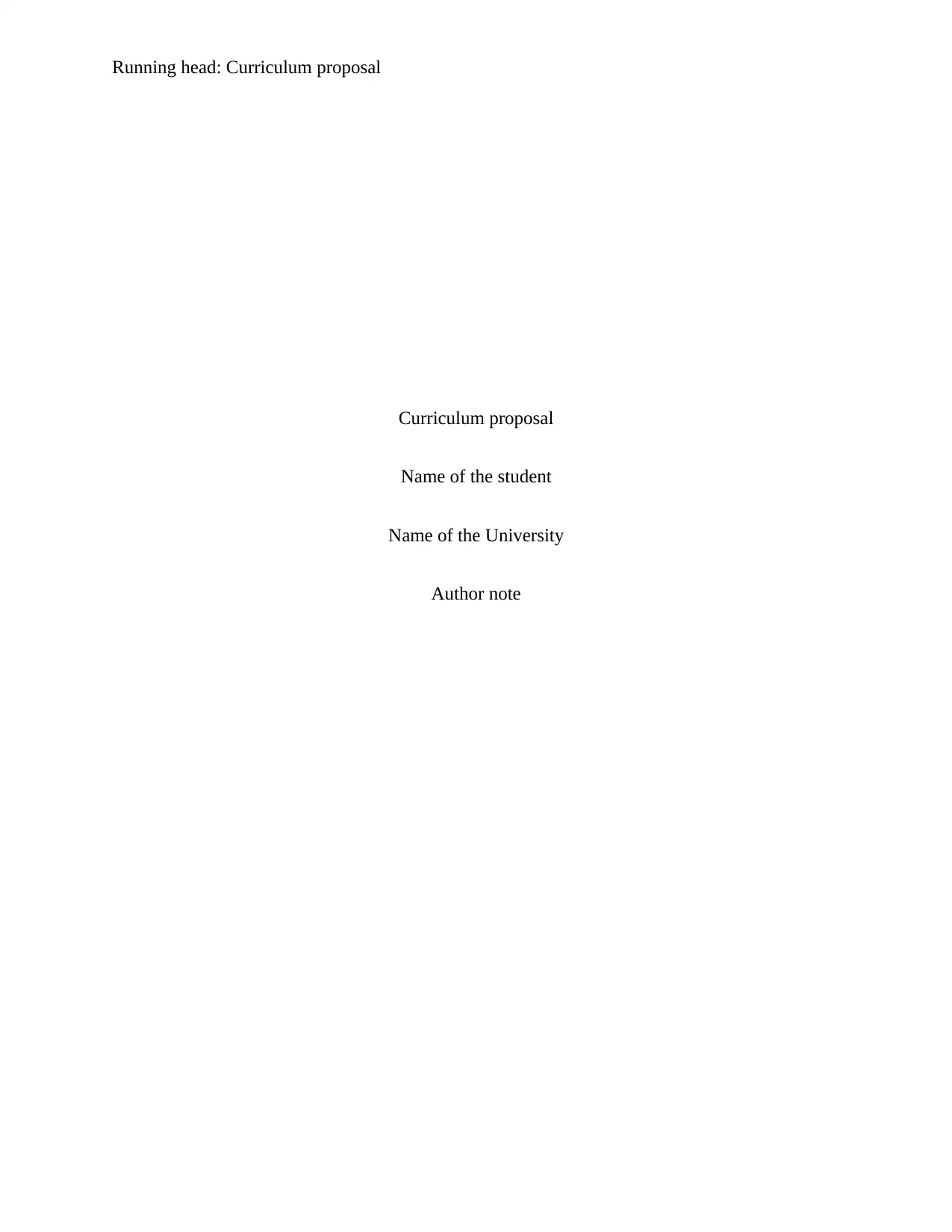
Running head: Curriculum proposal
Curriculum proposal
Name of the student
Name of the University
Author note
Curriculum proposal
Name of the student
Name of the University
Author note
Paraphrase This Document
Need a fresh take? Get an instant paraphrase of this document with our AI Paraphraser
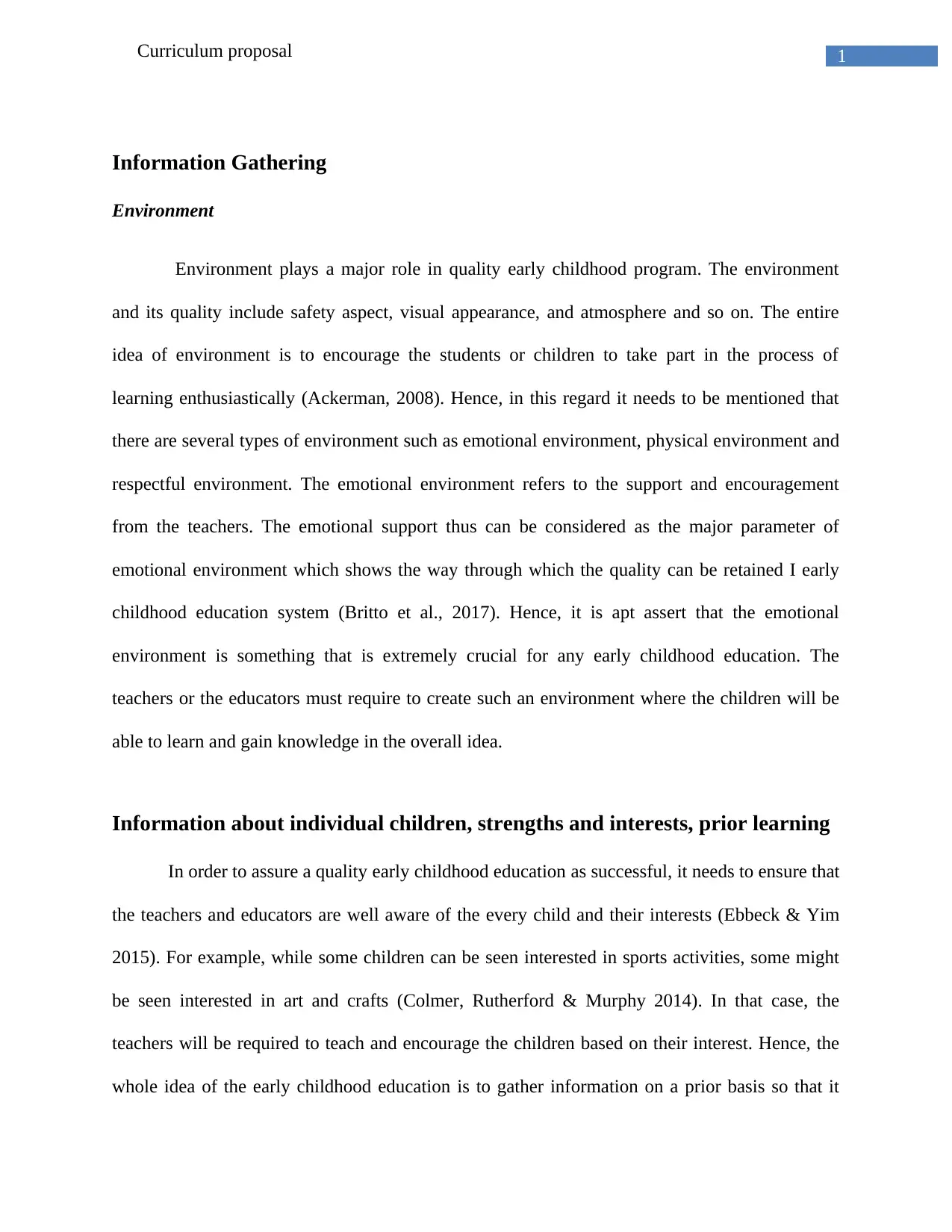
1Curriculum proposal
Information Gathering
Environment
Environment plays a major role in quality early childhood program. The environment
and its quality include safety aspect, visual appearance, and atmosphere and so on. The entire
idea of environment is to encourage the students or children to take part in the process of
learning enthusiastically (Ackerman, 2008). Hence, in this regard it needs to be mentioned that
there are several types of environment such as emotional environment, physical environment and
respectful environment. The emotional environment refers to the support and encouragement
from the teachers. The emotional support thus can be considered as the major parameter of
emotional environment which shows the way through which the quality can be retained I early
childhood education system (Britto et al., 2017). Hence, it is apt assert that the emotional
environment is something that is extremely crucial for any early childhood education. The
teachers or the educators must require to create such an environment where the children will be
able to learn and gain knowledge in the overall idea.
Information about individual children, strengths and interests, prior learning
In order to assure a quality early childhood education as successful, it needs to ensure that
the teachers and educators are well aware of the every child and their interests (Ebbeck & Yim
2015). For example, while some children can be seen interested in sports activities, some might
be seen interested in art and crafts (Colmer, Rutherford & Murphy 2014). In that case, the
teachers will be required to teach and encourage the children based on their interest. Hence, the
whole idea of the early childhood education is to gather information on a prior basis so that it
Information Gathering
Environment
Environment plays a major role in quality early childhood program. The environment
and its quality include safety aspect, visual appearance, and atmosphere and so on. The entire
idea of environment is to encourage the students or children to take part in the process of
learning enthusiastically (Ackerman, 2008). Hence, in this regard it needs to be mentioned that
there are several types of environment such as emotional environment, physical environment and
respectful environment. The emotional environment refers to the support and encouragement
from the teachers. The emotional support thus can be considered as the major parameter of
emotional environment which shows the way through which the quality can be retained I early
childhood education system (Britto et al., 2017). Hence, it is apt assert that the emotional
environment is something that is extremely crucial for any early childhood education. The
teachers or the educators must require to create such an environment where the children will be
able to learn and gain knowledge in the overall idea.
Information about individual children, strengths and interests, prior learning
In order to assure a quality early childhood education as successful, it needs to ensure that
the teachers and educators are well aware of the every child and their interests (Ebbeck & Yim
2015). For example, while some children can be seen interested in sports activities, some might
be seen interested in art and crafts (Colmer, Rutherford & Murphy 2014). In that case, the
teachers will be required to teach and encourage the children based on their interest. Hence, the
whole idea of the early childhood education is to gather information on a prior basis so that it
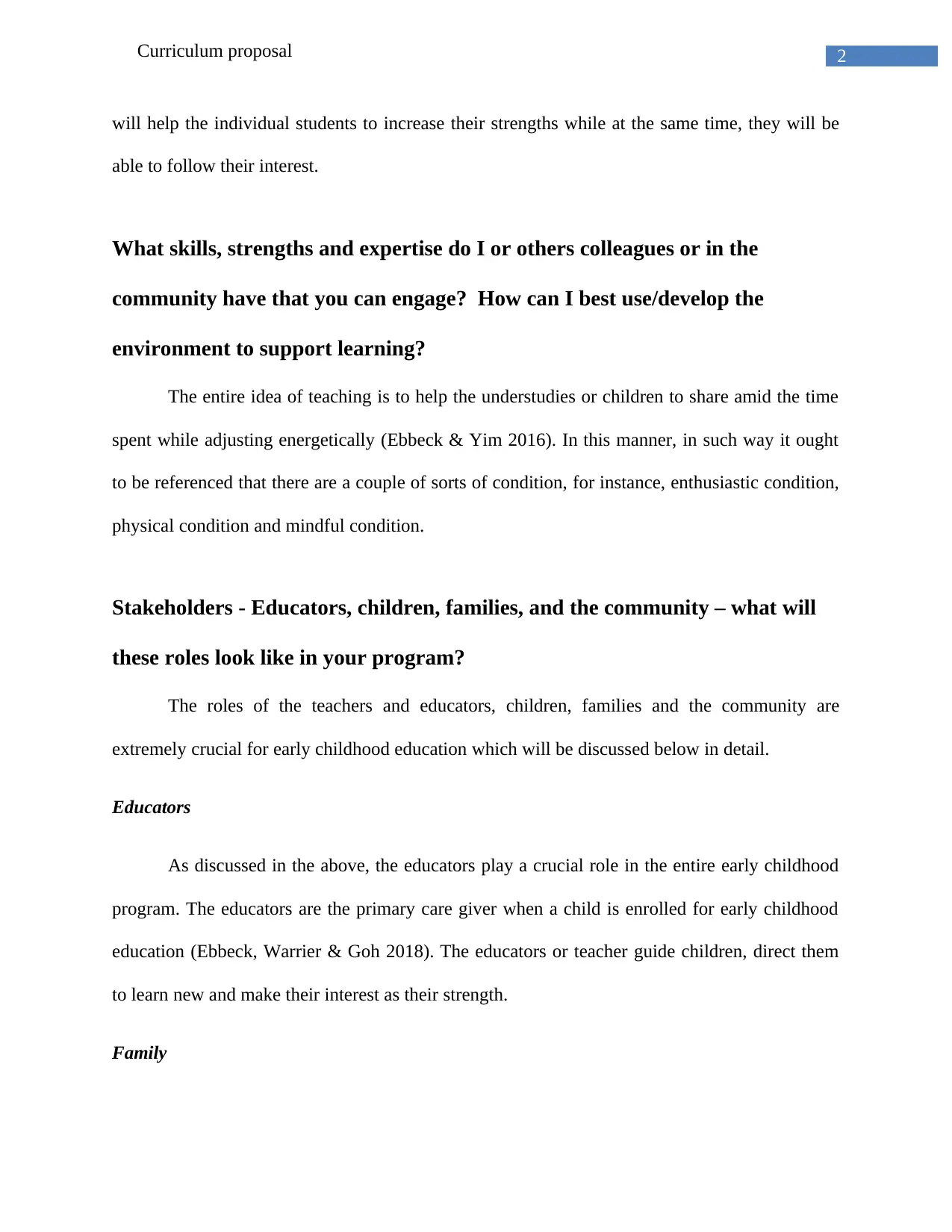
2Curriculum proposal
will help the individual students to increase their strengths while at the same time, they will be
able to follow their interest.
What skills, strengths and expertise do I or others colleagues or in the
community have that you can engage? How can I best use/develop the
environment to support learning?
The entire idea of teaching is to help the understudies or children to share amid the time
spent while adjusting energetically (Ebbeck & Yim 2016). In this manner, in such way it ought
to be referenced that there are a couple of sorts of condition, for instance, enthusiastic condition,
physical condition and mindful condition.
Stakeholders - Educators, children, families, and the community – what will
these roles look like in your program?
The roles of the teachers and educators, children, families and the community are
extremely crucial for early childhood education which will be discussed below in detail.
Educators
As discussed in the above, the educators play a crucial role in the entire early childhood
program. The educators are the primary care giver when a child is enrolled for early childhood
education (Ebbeck, Warrier & Goh 2018). The educators or teacher guide children, direct them
to learn new and make their interest as their strength.
Family
will help the individual students to increase their strengths while at the same time, they will be
able to follow their interest.
What skills, strengths and expertise do I or others colleagues or in the
community have that you can engage? How can I best use/develop the
environment to support learning?
The entire idea of teaching is to help the understudies or children to share amid the time
spent while adjusting energetically (Ebbeck & Yim 2016). In this manner, in such way it ought
to be referenced that there are a couple of sorts of condition, for instance, enthusiastic condition,
physical condition and mindful condition.
Stakeholders - Educators, children, families, and the community – what will
these roles look like in your program?
The roles of the teachers and educators, children, families and the community are
extremely crucial for early childhood education which will be discussed below in detail.
Educators
As discussed in the above, the educators play a crucial role in the entire early childhood
program. The educators are the primary care giver when a child is enrolled for early childhood
education (Ebbeck, Warrier & Goh 2018). The educators or teacher guide children, direct them
to learn new and make their interest as their strength.
Family
⊘ This is a preview!⊘
Do you want full access?
Subscribe today to unlock all pages.

Trusted by 1+ million students worldwide
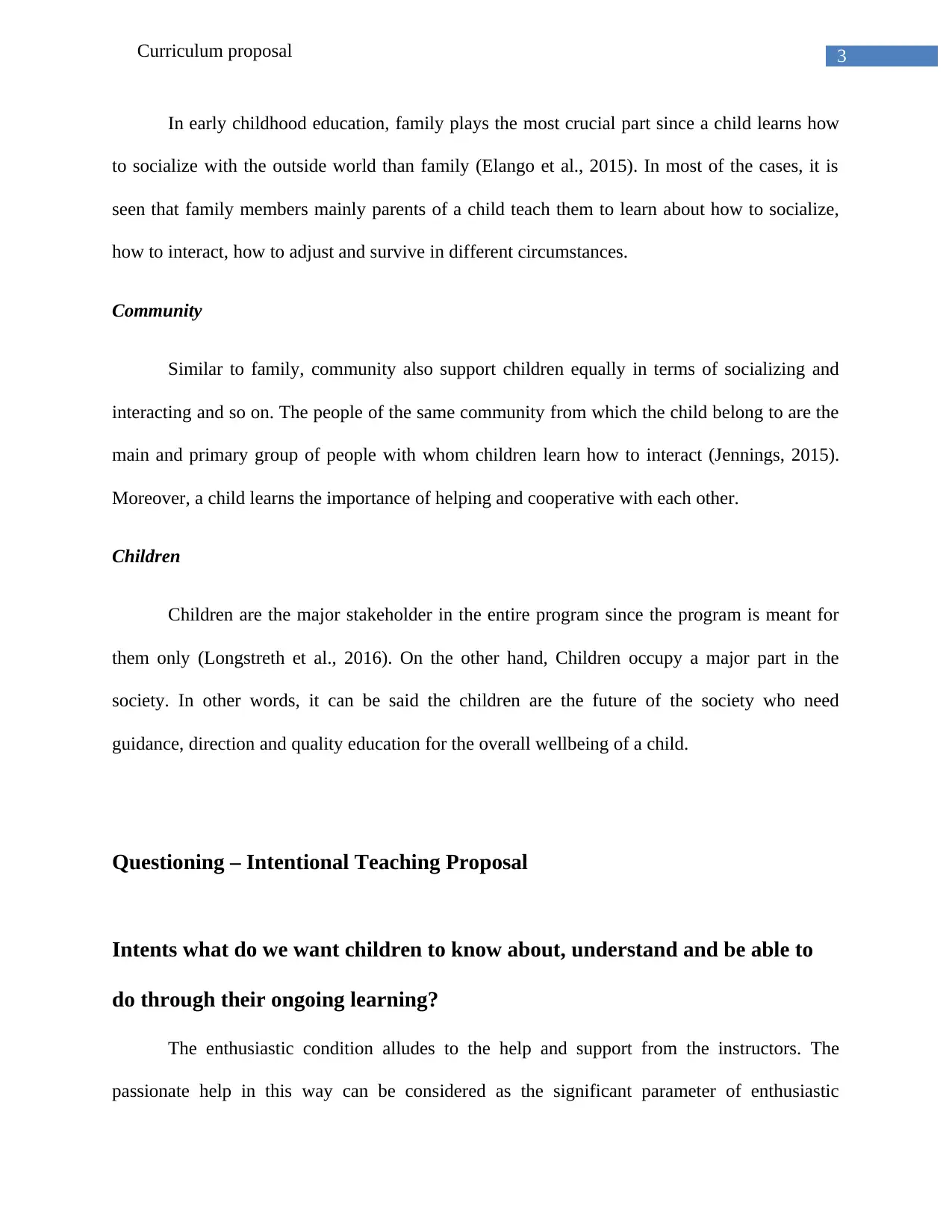
3Curriculum proposal
In early childhood education, family plays the most crucial part since a child learns how
to socialize with the outside world than family (Elango et al., 2015). In most of the cases, it is
seen that family members mainly parents of a child teach them to learn about how to socialize,
how to interact, how to adjust and survive in different circumstances.
Community
Similar to family, community also support children equally in terms of socializing and
interacting and so on. The people of the same community from which the child belong to are the
main and primary group of people with whom children learn how to interact (Jennings, 2015).
Moreover, a child learns the importance of helping and cooperative with each other.
Children
Children are the major stakeholder in the entire program since the program is meant for
them only (Longstreth et al., 2016). On the other hand, Children occupy a major part in the
society. In other words, it can be said the children are the future of the society who need
guidance, direction and quality education for the overall wellbeing of a child.
Questioning – Intentional Teaching Proposal
Intents what do we want children to know about, understand and be able to
do through their ongoing learning?
The enthusiastic condition alludes to the help and support from the instructors. The
passionate help in this way can be considered as the significant parameter of enthusiastic
In early childhood education, family plays the most crucial part since a child learns how
to socialize with the outside world than family (Elango et al., 2015). In most of the cases, it is
seen that family members mainly parents of a child teach them to learn about how to socialize,
how to interact, how to adjust and survive in different circumstances.
Community
Similar to family, community also support children equally in terms of socializing and
interacting and so on. The people of the same community from which the child belong to are the
main and primary group of people with whom children learn how to interact (Jennings, 2015).
Moreover, a child learns the importance of helping and cooperative with each other.
Children
Children are the major stakeholder in the entire program since the program is meant for
them only (Longstreth et al., 2016). On the other hand, Children occupy a major part in the
society. In other words, it can be said the children are the future of the society who need
guidance, direction and quality education for the overall wellbeing of a child.
Questioning – Intentional Teaching Proposal
Intents what do we want children to know about, understand and be able to
do through their ongoing learning?
The enthusiastic condition alludes to the help and support from the instructors. The
passionate help in this way can be considered as the significant parameter of enthusiastic
Paraphrase This Document
Need a fresh take? Get an instant paraphrase of this document with our AI Paraphraser
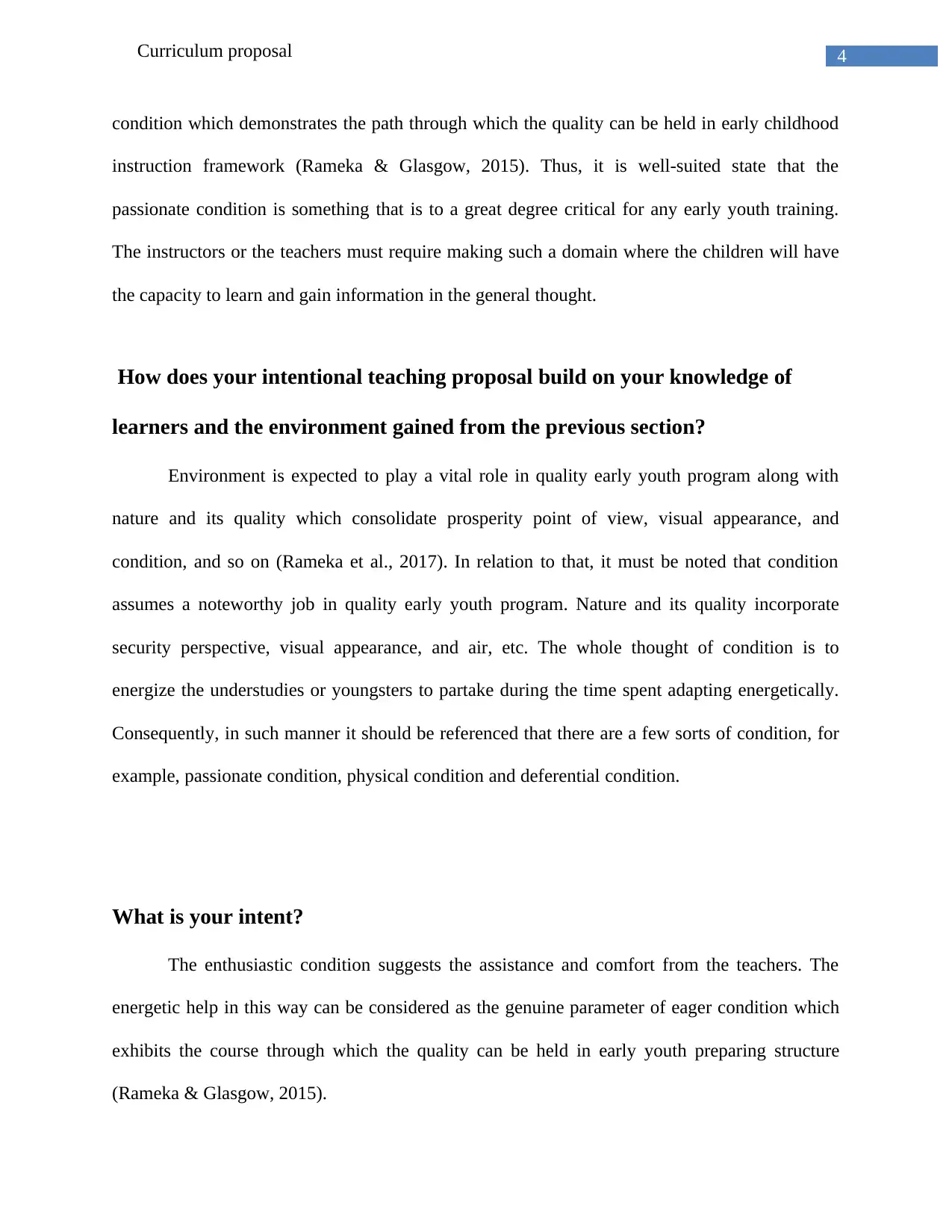
4Curriculum proposal
condition which demonstrates the path through which the quality can be held in early childhood
instruction framework (Rameka & Glasgow, 2015). Thus, it is well-suited state that the
passionate condition is something that is to a great degree critical for any early youth training.
The instructors or the teachers must require making such a domain where the children will have
the capacity to learn and gain information in the general thought.
How does your intentional teaching proposal build on your knowledge of
learners and the environment gained from the previous section?
Environment is expected to play a vital role in quality early youth program along with
nature and its quality which consolidate prosperity point of view, visual appearance, and
condition, and so on (Rameka et al., 2017). In relation to that, it must be noted that condition
assumes a noteworthy job in quality early youth program. Nature and its quality incorporate
security perspective, visual appearance, and air, etc. The whole thought of condition is to
energize the understudies or youngsters to partake during the time spent adapting energetically.
Consequently, in such manner it should be referenced that there are a few sorts of condition, for
example, passionate condition, physical condition and deferential condition.
What is your intent?
The enthusiastic condition suggests the assistance and comfort from the teachers. The
energetic help in this way can be considered as the genuine parameter of eager condition which
exhibits the course through which the quality can be held in early youth preparing structure
(Rameka & Glasgow, 2015).
condition which demonstrates the path through which the quality can be held in early childhood
instruction framework (Rameka & Glasgow, 2015). Thus, it is well-suited state that the
passionate condition is something that is to a great degree critical for any early youth training.
The instructors or the teachers must require making such a domain where the children will have
the capacity to learn and gain information in the general thought.
How does your intentional teaching proposal build on your knowledge of
learners and the environment gained from the previous section?
Environment is expected to play a vital role in quality early youth program along with
nature and its quality which consolidate prosperity point of view, visual appearance, and
condition, and so on (Rameka et al., 2017). In relation to that, it must be noted that condition
assumes a noteworthy job in quality early youth program. Nature and its quality incorporate
security perspective, visual appearance, and air, etc. The whole thought of condition is to
energize the understudies or youngsters to partake during the time spent adapting energetically.
Consequently, in such manner it should be referenced that there are a few sorts of condition, for
example, passionate condition, physical condition and deferential condition.
What is your intent?
The enthusiastic condition suggests the assistance and comfort from the teachers. The
energetic help in this way can be considered as the genuine parameter of eager condition which
exhibits the course through which the quality can be held in early youth preparing structure
(Rameka & Glasgow, 2015).
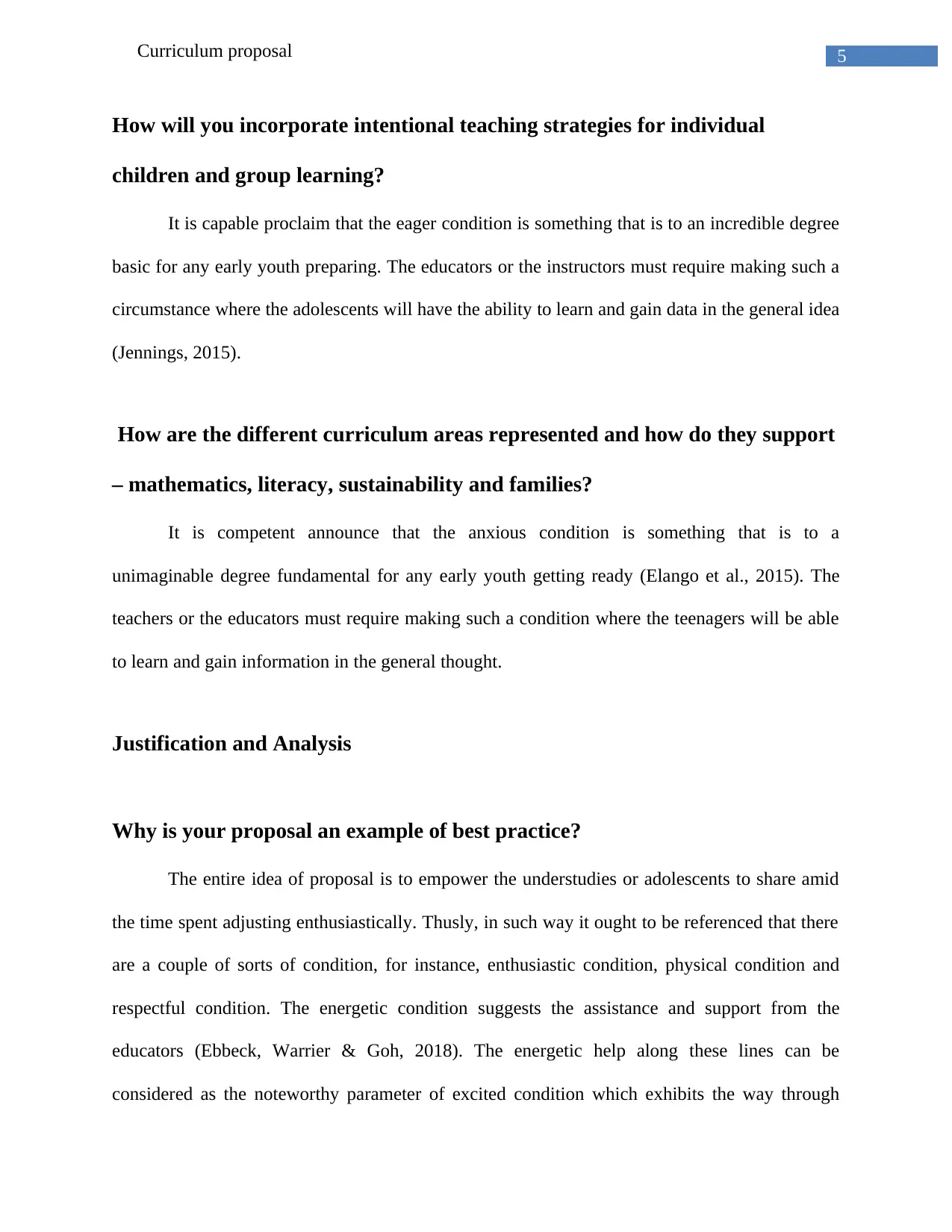
5Curriculum proposal
How will you incorporate intentional teaching strategies for individual
children and group learning?
It is capable proclaim that the eager condition is something that is to an incredible degree
basic for any early youth preparing. The educators or the instructors must require making such a
circumstance where the adolescents will have the ability to learn and gain data in the general idea
(Jennings, 2015).
How are the different curriculum areas represented and how do they support
– mathematics, literacy, sustainability and families?
It is competent announce that the anxious condition is something that is to a
unimaginable degree fundamental for any early youth getting ready (Elango et al., 2015). The
teachers or the educators must require making such a condition where the teenagers will be able
to learn and gain information in the general thought.
Justification and Analysis
Why is your proposal an example of best practice?
The entire idea of proposal is to empower the understudies or adolescents to share amid
the time spent adjusting enthusiastically. Thusly, in such way it ought to be referenced that there
are a couple of sorts of condition, for instance, enthusiastic condition, physical condition and
respectful condition. The energetic condition suggests the assistance and support from the
educators (Ebbeck, Warrier & Goh, 2018). The energetic help along these lines can be
considered as the noteworthy parameter of excited condition which exhibits the way through
How will you incorporate intentional teaching strategies for individual
children and group learning?
It is capable proclaim that the eager condition is something that is to an incredible degree
basic for any early youth preparing. The educators or the instructors must require making such a
circumstance where the adolescents will have the ability to learn and gain data in the general idea
(Jennings, 2015).
How are the different curriculum areas represented and how do they support
– mathematics, literacy, sustainability and families?
It is competent announce that the anxious condition is something that is to a
unimaginable degree fundamental for any early youth getting ready (Elango et al., 2015). The
teachers or the educators must require making such a condition where the teenagers will be able
to learn and gain information in the general thought.
Justification and Analysis
Why is your proposal an example of best practice?
The entire idea of proposal is to empower the understudies or adolescents to share amid
the time spent adjusting enthusiastically. Thusly, in such way it ought to be referenced that there
are a couple of sorts of condition, for instance, enthusiastic condition, physical condition and
respectful condition. The energetic condition suggests the assistance and support from the
educators (Ebbeck, Warrier & Goh, 2018). The energetic help along these lines can be
considered as the noteworthy parameter of excited condition which exhibits the way through
⊘ This is a preview!⊘
Do you want full access?
Subscribe today to unlock all pages.

Trusted by 1+ million students worldwide
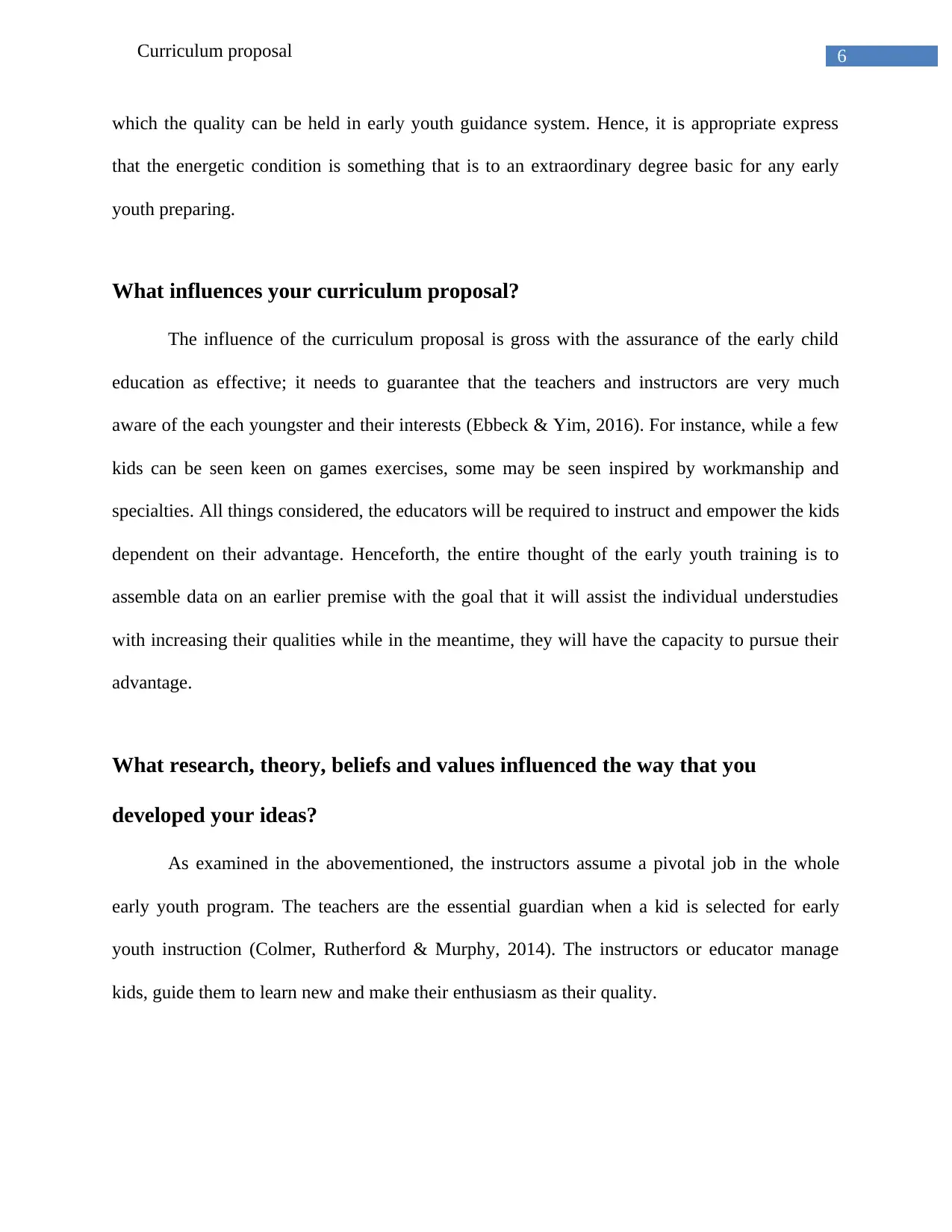
6Curriculum proposal
which the quality can be held in early youth guidance system. Hence, it is appropriate express
that the energetic condition is something that is to an extraordinary degree basic for any early
youth preparing.
What influences your curriculum proposal?
The influence of the curriculum proposal is gross with the assurance of the early child
education as effective; it needs to guarantee that the teachers and instructors are very much
aware of the each youngster and their interests (Ebbeck & Yim, 2016). For instance, while a few
kids can be seen keen on games exercises, some may be seen inspired by workmanship and
specialties. All things considered, the educators will be required to instruct and empower the kids
dependent on their advantage. Henceforth, the entire thought of the early youth training is to
assemble data on an earlier premise with the goal that it will assist the individual understudies
with increasing their qualities while in the meantime, they will have the capacity to pursue their
advantage.
What research, theory, beliefs and values influenced the way that you
developed your ideas?
As examined in the abovementioned, the instructors assume a pivotal job in the whole
early youth program. The teachers are the essential guardian when a kid is selected for early
youth instruction (Colmer, Rutherford & Murphy, 2014). The instructors or educator manage
kids, guide them to learn new and make their enthusiasm as their quality.
which the quality can be held in early youth guidance system. Hence, it is appropriate express
that the energetic condition is something that is to an extraordinary degree basic for any early
youth preparing.
What influences your curriculum proposal?
The influence of the curriculum proposal is gross with the assurance of the early child
education as effective; it needs to guarantee that the teachers and instructors are very much
aware of the each youngster and their interests (Ebbeck & Yim, 2016). For instance, while a few
kids can be seen keen on games exercises, some may be seen inspired by workmanship and
specialties. All things considered, the educators will be required to instruct and empower the kids
dependent on their advantage. Henceforth, the entire thought of the early youth training is to
assemble data on an earlier premise with the goal that it will assist the individual understudies
with increasing their qualities while in the meantime, they will have the capacity to pursue their
advantage.
What research, theory, beliefs and values influenced the way that you
developed your ideas?
As examined in the abovementioned, the instructors assume a pivotal job in the whole
early youth program. The teachers are the essential guardian when a kid is selected for early
youth instruction (Colmer, Rutherford & Murphy, 2014). The instructors or educator manage
kids, guide them to learn new and make their enthusiasm as their quality.
Paraphrase This Document
Need a fresh take? Get an instant paraphrase of this document with our AI Paraphraser
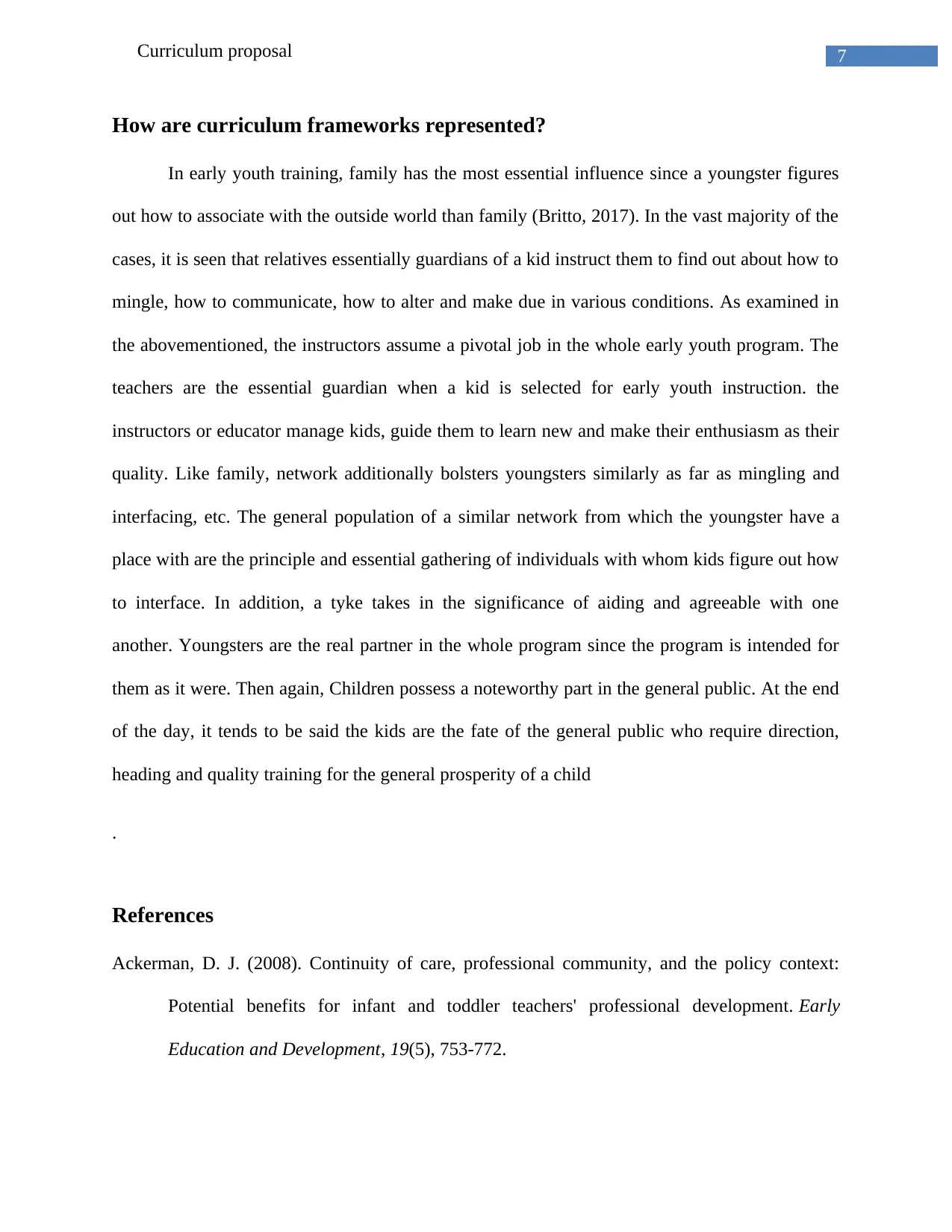
7Curriculum proposal
How are curriculum frameworks represented?
In early youth training, family has the most essential influence since a youngster figures
out how to associate with the outside world than family (Britto, 2017). In the vast majority of the
cases, it is seen that relatives essentially guardians of a kid instruct them to find out about how to
mingle, how to communicate, how to alter and make due in various conditions. As examined in
the abovementioned, the instructors assume a pivotal job in the whole early youth program. The
teachers are the essential guardian when a kid is selected for early youth instruction. the
instructors or educator manage kids, guide them to learn new and make their enthusiasm as their
quality. Like family, network additionally bolsters youngsters similarly as far as mingling and
interfacing, etc. The general population of a similar network from which the youngster have a
place with are the principle and essential gathering of individuals with whom kids figure out how
to interface. In addition, a tyke takes in the significance of aiding and agreeable with one
another. Youngsters are the real partner in the whole program since the program is intended for
them as it were. Then again, Children possess a noteworthy part in the general public. At the end
of the day, it tends to be said the kids are the fate of the general public who require direction,
heading and quality training for the general prosperity of a child
.
References
Ackerman, D. J. (2008). Continuity of care, professional community, and the policy context:
Potential benefits for infant and toddler teachers' professional development. Early
Education and Development, 19(5), 753-772.
How are curriculum frameworks represented?
In early youth training, family has the most essential influence since a youngster figures
out how to associate with the outside world than family (Britto, 2017). In the vast majority of the
cases, it is seen that relatives essentially guardians of a kid instruct them to find out about how to
mingle, how to communicate, how to alter and make due in various conditions. As examined in
the abovementioned, the instructors assume a pivotal job in the whole early youth program. The
teachers are the essential guardian when a kid is selected for early youth instruction. the
instructors or educator manage kids, guide them to learn new and make their enthusiasm as their
quality. Like family, network additionally bolsters youngsters similarly as far as mingling and
interfacing, etc. The general population of a similar network from which the youngster have a
place with are the principle and essential gathering of individuals with whom kids figure out how
to interface. In addition, a tyke takes in the significance of aiding and agreeable with one
another. Youngsters are the real partner in the whole program since the program is intended for
them as it were. Then again, Children possess a noteworthy part in the general public. At the end
of the day, it tends to be said the kids are the fate of the general public who require direction,
heading and quality training for the general prosperity of a child
.
References
Ackerman, D. J. (2008). Continuity of care, professional community, and the policy context:
Potential benefits for infant and toddler teachers' professional development. Early
Education and Development, 19(5), 753-772.
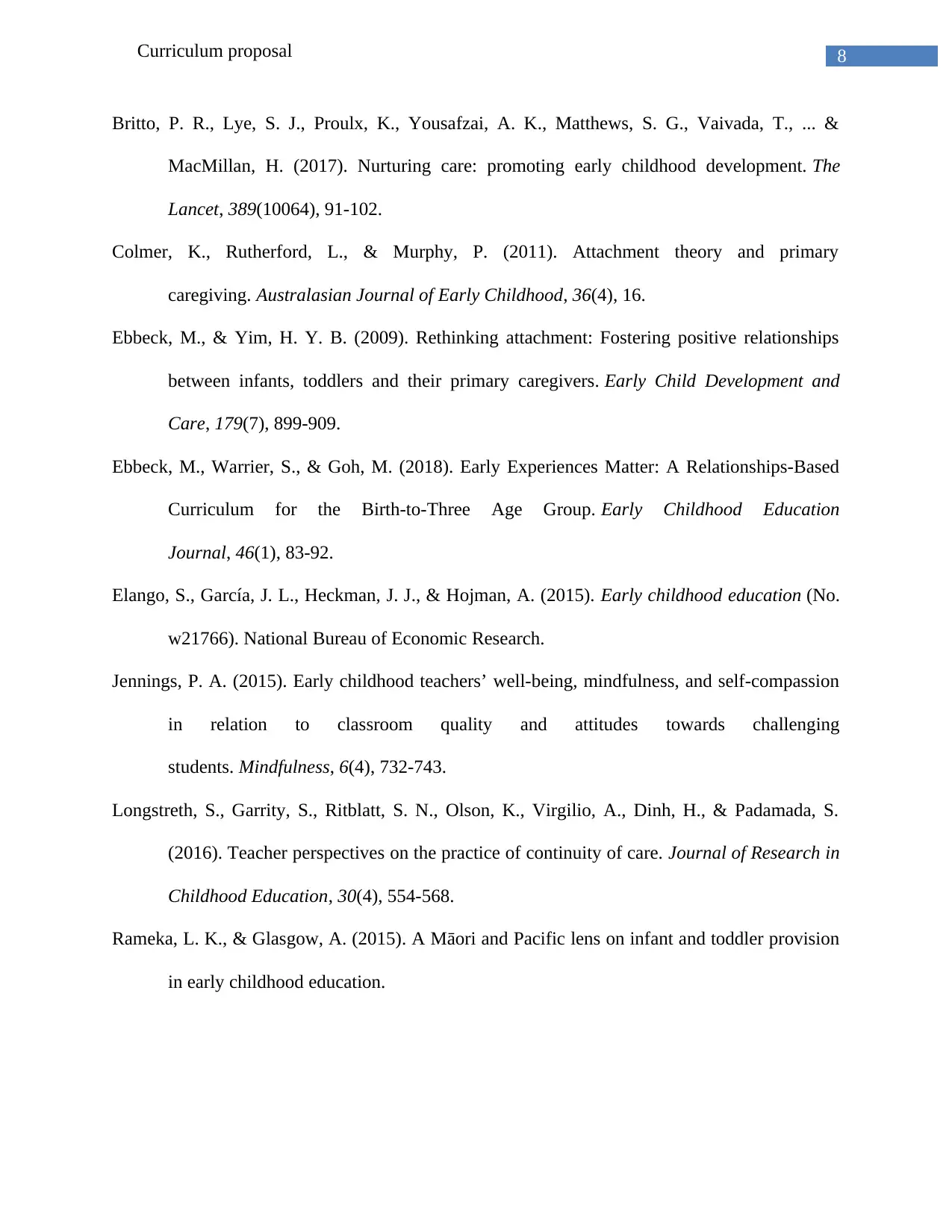
8Curriculum proposal
Britto, P. R., Lye, S. J., Proulx, K., Yousafzai, A. K., Matthews, S. G., Vaivada, T., ... &
MacMillan, H. (2017). Nurturing care: promoting early childhood development. The
Lancet, 389(10064), 91-102.
Colmer, K., Rutherford, L., & Murphy, P. (2011). Attachment theory and primary
caregiving. Australasian Journal of Early Childhood, 36(4), 16.
Ebbeck, M., & Yim, H. Y. B. (2009). Rethinking attachment: Fostering positive relationships
between infants, toddlers and their primary caregivers. Early Child Development and
Care, 179(7), 899-909.
Ebbeck, M., Warrier, S., & Goh, M. (2018). Early Experiences Matter: A Relationships-Based
Curriculum for the Birth-to-Three Age Group. Early Childhood Education
Journal, 46(1), 83-92.
Elango, S., García, J. L., Heckman, J. J., & Hojman, A. (2015). Early childhood education (No.
w21766). National Bureau of Economic Research.
Jennings, P. A. (2015). Early childhood teachers’ well-being, mindfulness, and self-compassion
in relation to classroom quality and attitudes towards challenging
students. Mindfulness, 6(4), 732-743.
Longstreth, S., Garrity, S., Ritblatt, S. N., Olson, K., Virgilio, A., Dinh, H., & Padamada, S.
(2016). Teacher perspectives on the practice of continuity of care. Journal of Research in
Childhood Education, 30(4), 554-568.
Rameka, L. K., & Glasgow, A. (2015). A Māori and Pacific lens on infant and toddler provision
in early childhood education.
Britto, P. R., Lye, S. J., Proulx, K., Yousafzai, A. K., Matthews, S. G., Vaivada, T., ... &
MacMillan, H. (2017). Nurturing care: promoting early childhood development. The
Lancet, 389(10064), 91-102.
Colmer, K., Rutherford, L., & Murphy, P. (2011). Attachment theory and primary
caregiving. Australasian Journal of Early Childhood, 36(4), 16.
Ebbeck, M., & Yim, H. Y. B. (2009). Rethinking attachment: Fostering positive relationships
between infants, toddlers and their primary caregivers. Early Child Development and
Care, 179(7), 899-909.
Ebbeck, M., Warrier, S., & Goh, M. (2018). Early Experiences Matter: A Relationships-Based
Curriculum for the Birth-to-Three Age Group. Early Childhood Education
Journal, 46(1), 83-92.
Elango, S., García, J. L., Heckman, J. J., & Hojman, A. (2015). Early childhood education (No.
w21766). National Bureau of Economic Research.
Jennings, P. A. (2015). Early childhood teachers’ well-being, mindfulness, and self-compassion
in relation to classroom quality and attitudes towards challenging
students. Mindfulness, 6(4), 732-743.
Longstreth, S., Garrity, S., Ritblatt, S. N., Olson, K., Virgilio, A., Dinh, H., & Padamada, S.
(2016). Teacher perspectives on the practice of continuity of care. Journal of Research in
Childhood Education, 30(4), 554-568.
Rameka, L. K., & Glasgow, A. (2015). A Māori and Pacific lens on infant and toddler provision
in early childhood education.
⊘ This is a preview!⊘
Do you want full access?
Subscribe today to unlock all pages.

Trusted by 1+ million students worldwide
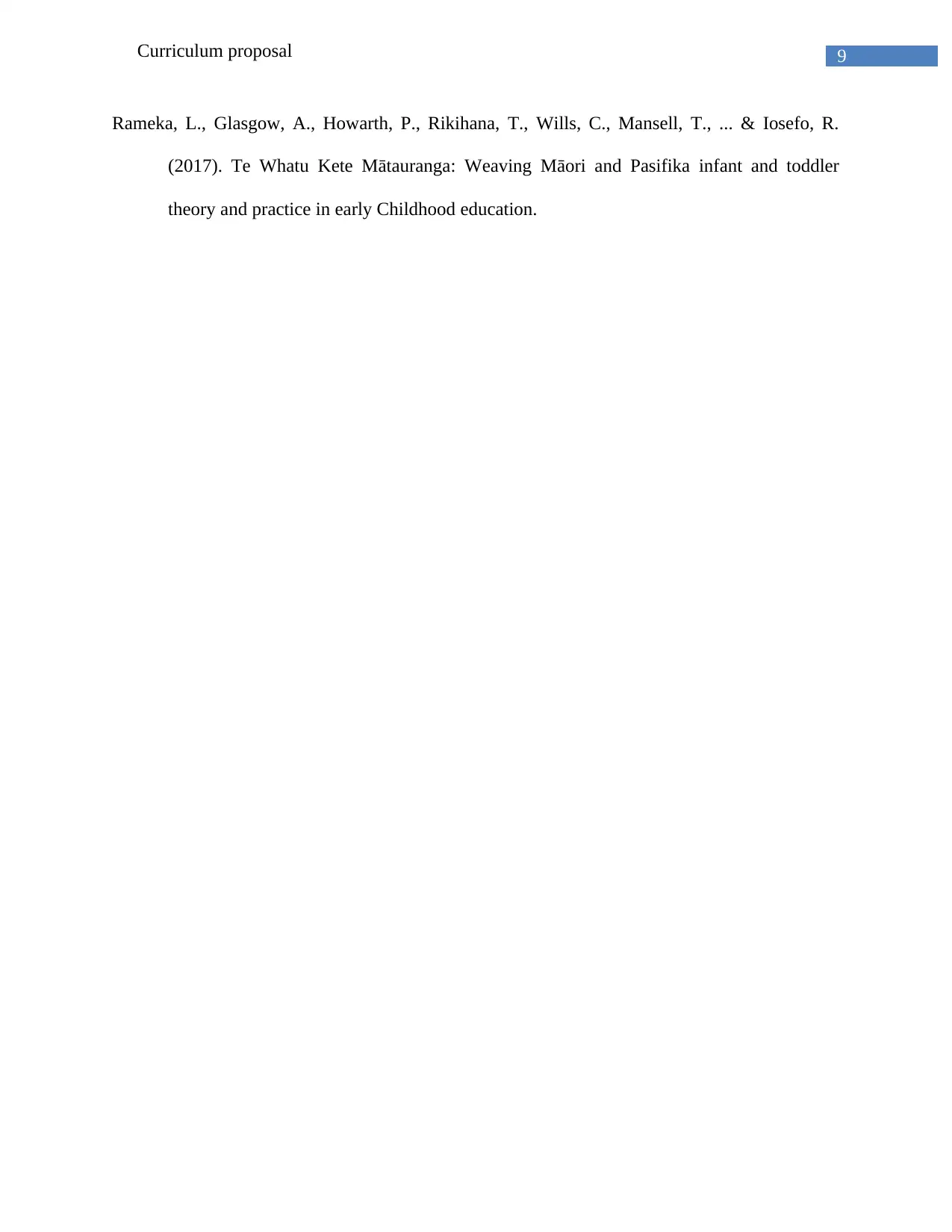
9Curriculum proposal
Rameka, L., Glasgow, A., Howarth, P., Rikihana, T., Wills, C., Mansell, T., ... & Iosefo, R.
(2017). Te Whatu Kete Mātauranga: Weaving Māori and Pasifika infant and toddler
theory and practice in early Childhood education.
Rameka, L., Glasgow, A., Howarth, P., Rikihana, T., Wills, C., Mansell, T., ... & Iosefo, R.
(2017). Te Whatu Kete Mātauranga: Weaving Māori and Pasifika infant and toddler
theory and practice in early Childhood education.
1 out of 10
Related Documents
Your All-in-One AI-Powered Toolkit for Academic Success.
+13062052269
info@desklib.com
Available 24*7 on WhatsApp / Email
![[object Object]](/_next/static/media/star-bottom.7253800d.svg)
Unlock your academic potential
Copyright © 2020–2025 A2Z Services. All Rights Reserved. Developed and managed by ZUCOL.





